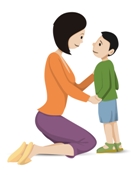Dealing With A Child’s Big Emotions
Did you know acknowledging a child’s feelings helps to calm the reactive part of their brain? That’s right, by empathetically naming and acknowledging the feelings  that a child is experiencing, there is a physiological response in their brain which involves calming neo-transmitters being squirted into the lower, more reactive part of his or her brain.
that a child is experiencing, there is a physiological response in their brain which involves calming neo-transmitters being squirted into the lower, more reactive part of his or her brain.
This practice of acknowledging a child’s feelings can feel counter-productive and even ridicules at times. A more instinctive response to a child’s emotions is to dismiss them, deny the validity of them or to try to talk them out of them.
Acknowledging a child’s feelings takes practice and patience and consciously reminding oneself that from the child’s perspective the feelings and emotions that he or she is experiencing and/or expressing are legitimate and real.
The fact is that even as adults, we have feelings and express emotions that may seem out of perspective to others. And when someone denies the validity of those emotions, it only serves to make us feel misunderstood and perhaps more frustrated or even angry.
But when someone acknowledges that we’re feeling upset and that they’re there for us, it affirms our worth as a person and serves to help us to feel empowered to deal with the emotion or situation in spite of how difficult it might feel at the time.
This type of response to a person’s emotions is what true empathy is about. It’s about being there in the moment without judgment.
Acknowledging emotions without judgment can tame a temper tantrum or other strong emotional reaction, as well as promote a more positive outcome for both you and the child. In addition, it serves to develop your child’s emotional intelligence.
So what’s the difference between acknowledging a child’s emotions rather than dismissing or denying him or her of having them? Let’s look at a few examples that contrast how adults might typically respond to a child’s emotions and what a more empathetical (and more soothing) response would sound like.
Scenario:
You’re leaving your child to go to work: Child is crying “Don’t go! Don’t leave me!”
Typical adult response: “Don’t cry. Mommy will be back after work.’ (This is a downplay of the situation and somewhat of a putdown! In the child’s world, this is a big deal!)
A more empathetical response: “It’s hard to see Mommy go isn’t it?”
Scenario:
Child is angry because his time is up with a toy.
Typical adult response: “Give the toy to your friend. You’re being selfish! Can’t you see it’s his turn?” (This is an attempt to reason, talk the child out of their disappointment and another putdown.)
A more empathetical response: “It’s hard to share sometimes, isn’t it?”
Scenario:
Child is crying over something you see as unnecessary.
Typical adult response: “Don’t be silly; there’s nothing for you to be upset about.”
A more empathetical response: “I can see you feel sad (or upset). I’m here for you.” (Hugs often work wonders in these sort of situations.)
Of course, it’s not always as simple as a quick acknowledgement. You may need to stay in the moment WITH the child and continue to be emotionally responsive.
In my workshops and in my online Discipline with Influence Program, I advise parents, caregivers and teachers to be mindful in response to a child’s behaviour and emotions and to apply a 3 to 5 second rule before responding. These few seconds provide the time to take a step back mentally, calm your own brain and be responsive to the child rather than reactive.
Being emotionally responsive vs. reactive will serve to calm the child, validate their feelings and make them feel heard. This process can be the difference between the child feeling dismissed and misunderstood or the child feeling validated and understood.
Keep in mind, emotions expressed are better than unexpressed and pent up emotions. In the Discipline with Influence Online Program I provide a myriad of ways to help children develop emotional intelligence and express their emotions in healthy ways!
